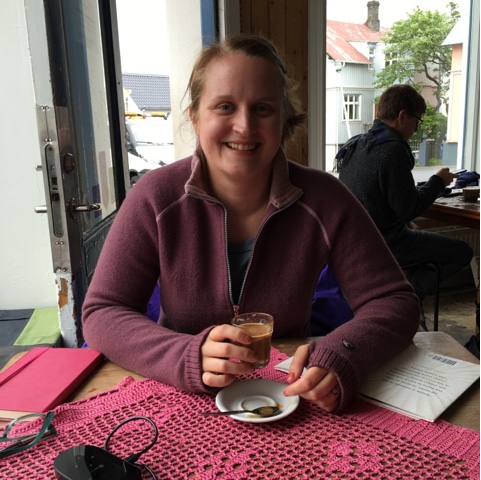First, hospitals will likely have a dress code of some sort. Chaplains fall into the "professional" category of employees, but do most of their work in clinical areas and have direct patient contact. Other professionals who fall into this category include social workers, registered dietitians, pharmacists and psychotherapists. At the bare minimum, hospital dress codes usually include closed-toe shoes, socks (no flats for women unless wearing tights or socks), and what is termed "professional/business casual attire." For women this can be button-down shirts, slacks, cardigans, skirts, etc. Some hospitals have their own specifics. I've worked at facilities that required me to cover my forearm tattoo (hence why I have a wide variety of cardigans). My current employer has requested that we dress "for safety", which means no dangling scarves, neckties, earrings, necklaces, etc, that could be become hazardous by being pulled by patient or caught while doing a task.
Next, think about what you need from your clothing to complete your tasks at work. I carry two pagers simultaneously, which means I need somewhere to clip them. For this reason, dresses don't work for me and I never wear them to work. I will wear skirts if they have a tailored waistband that can support the pagers. I also need pockets because I am frequently carrying around pieces of paper, rosaries, and other things. My work requires standing, but also bending my knees and squatting down next to beds or chairs, and lots of walking around. I have found that what works best for me to wear are high-end tailored neutral color scrub pants. My favorite style is the five pocket pant from Grey's Anatomy by Barco. I have them in black, charcoal and khaki.
 |
| This is a typical summer work outfit |
 |
| This is a typical cooler weather work outfit for me. |
Third, think about your clothing as it relates to infection prevention for yourself and for your patients. Some units (at my hospital the SICU and Burn Unit) require you to remove a sweater, jacket, cardigan or lab coat upon entry. Everything I wear to work is machine washable, because I have no interest in dry cleaning. As evening chaplain, I am on every single unit. I could be in the ER with extremely injured patients, I could be on the burn unit with patients at high risk of infection, I could be on labor and delivery or I could be visiting someone on enteric or contact isolation precautions in the MICU. I do not want my clothing to become an infection vector for myself, my family, or other patients. So once I wear something to work it goes directly into the hamper at home until it is washed.
Shoes are an important consideration when it comes to comfort, functionality and safety. I wear a dedicated pair of Danskos to work. They are the Pro XP model, which has a slip resistant sole and removable insole. I have custom orthotics which fit into the clogs. I walk about 14-16k steps per day at work, so comfortable shoes are a must. I wear these shoes pretty much only to work and they live just inside my front door because I have no desire to track anything nasty into my home.
With regards to accessories, I wear a watch or fitbit everyday. I note when I enter and exit a patient's room, because I must enter that into a chart note later. I have a work notebook that is covered with leather and has a pen attached for this purpose. It has taken many iterations to find a system that works for me. Sometimes I use scraps of paper, but I find that the notebook is useful for keeping track of information for more than one shift and sometimes patients or families will request a blank sheet of paper and I can just tear one out of my notebook for them. I usually have one or two pens clipped to my shirt or in my pockets also because pens are a hot commodity in a hospital. Hospitals require you to wear a name badge in a place that is visible above the waist. I wear mine clipped to my collar on the left side. This gives me access to hospital doors, the employee parking garage, and identifies me as someone who belongs at the hospital.
A note on clergy shirts for chaplains:
I would never wear a clergy shirt while visiting patients in my work as chaplain. For me, a clerical collar belongs in a parish as a work uniform for the pastor or preacher. Just as I would never wear my employee badge to preach in a congregation, I would never wear my clergy shirt to the hospital while employed as chaplain. I find that the image of a clergy collar can be off-putting to patients who might have had bad experiences with church and who are already in an extremely vulnerable state while being hospitalized. For me, not wearing a clergy shirt is a matter of hospitality. I also find that outside my specific Lutheran context, a woman in a clergy shirt is confusing and controversial. I find that the shirt is a distraction more than a comfort. People know that I am not a Catholic priest but cannot seem to make the required leap that I am a pastor. Additionally, chaplains are interfaith. I visit patients who are Christian, but also Jewish, Muslim, Buddhist, Hmong, or no particular religious tradition at all. A clergy shirt can create barriers to conversation or create a sense of exclusion.

















































